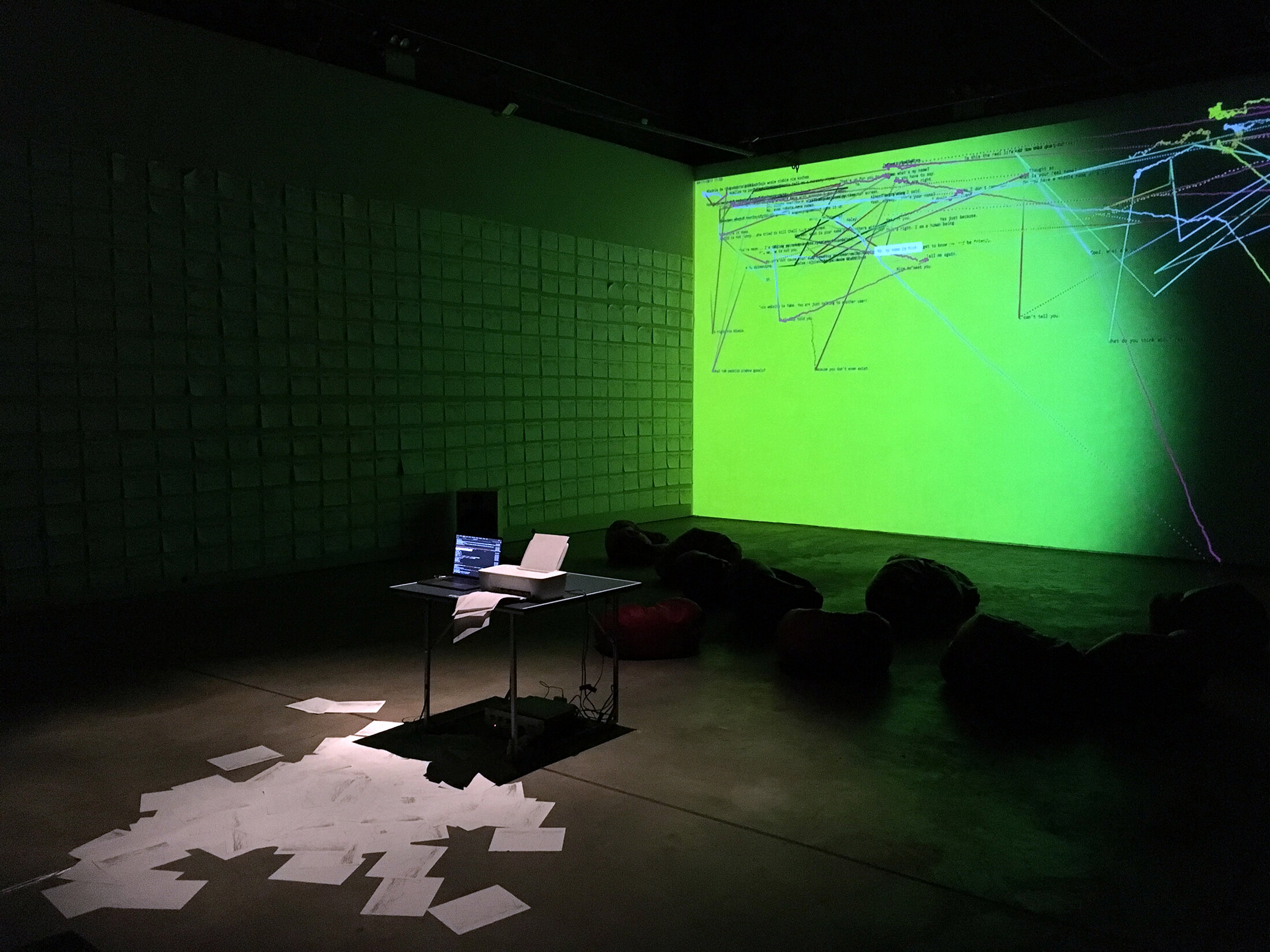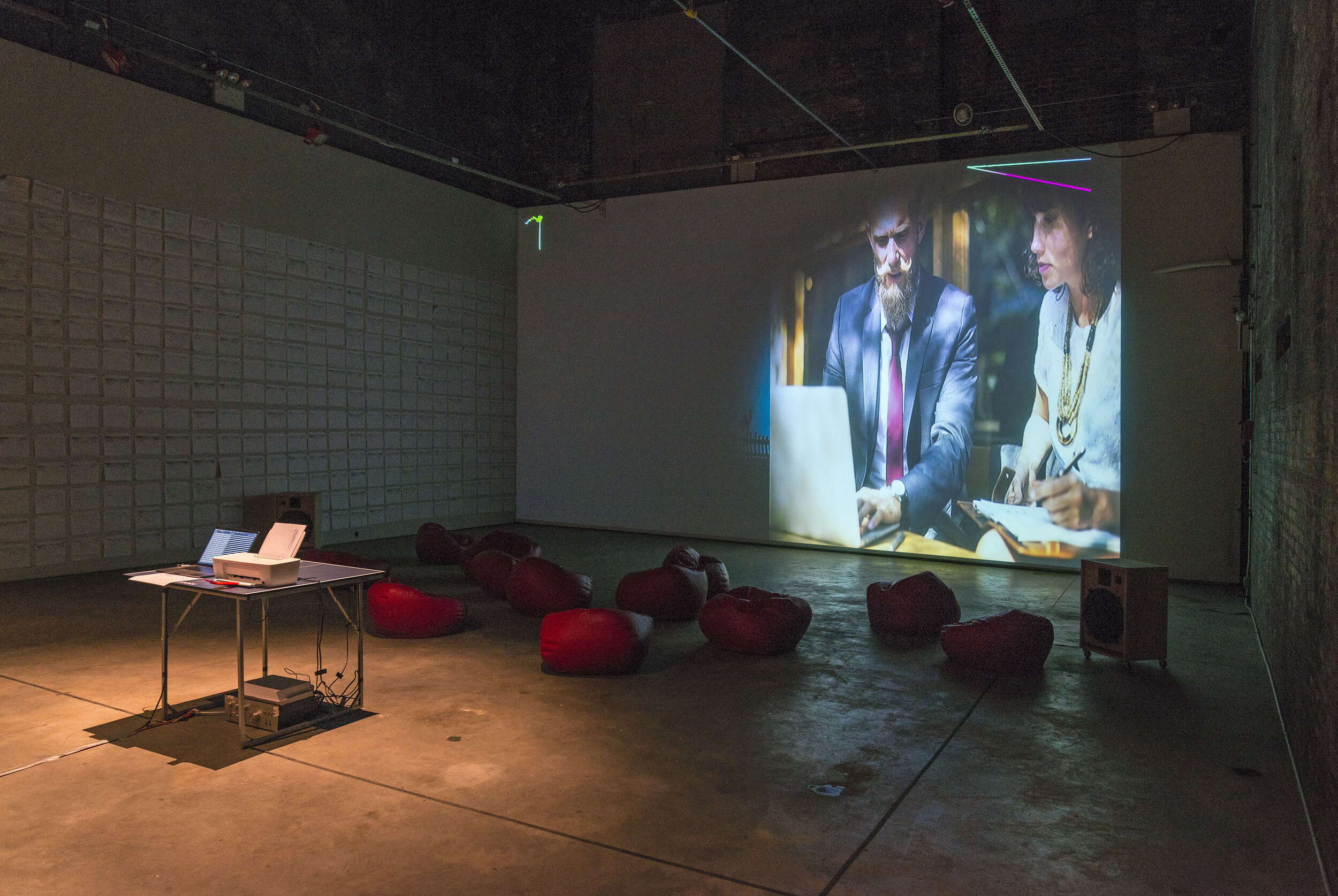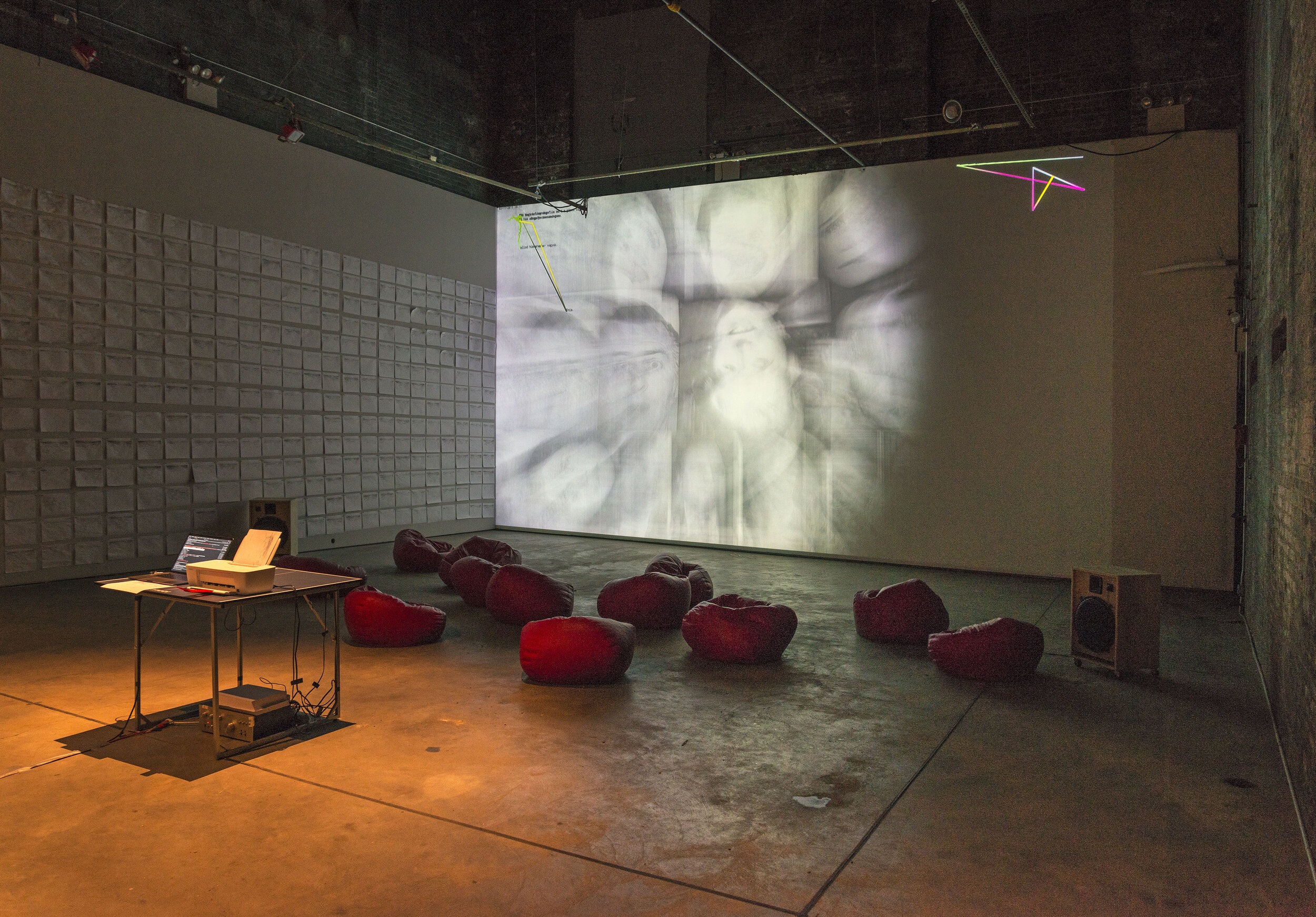
All Images: Installation views, The Boiler, Brooklyn, NY
Materials: Projection, Laptop, Speakers, Sound, Printer, Printouts, Ping Pong Table
Press Release after images below



















Extended video excerpt
Press Release
We are excited to present verbolect at The BOILER. verbolect is an extended conversation between the chatbot Cleverbot and itself, continuously, for a month. The conversation will begin at the start of the exhibition and will be spoken audibly. The emotional content of the words spoken will be translated into an animated projection that will evolve in sync with the emergent mental state of the bot. A webcam will broadcast from the space via a 24-hour live feed on YouTube, so that viewers can eavesdrop at any time, day or night. “In essence, we’re forcing a robot to interrogate itself for an extreme duration. The emotional degree and intensity of each phrase spoken, and consequent reaction, will propel the projected ‘eye’ of the bot, as its emotive state changes. Where the conversation goes is completely out of our control.” (O’Connor)
Cleverbot is possibly the most human chatbot ever created, and Rollo Carpenter—its creator—is a leader in linguistic artificial intelligence. He and it have been featured on the podcast Radiolab and discussed in Brian Christian’s book The Most Human Human. Carpenter invented Cleverbot over twenty years ago and taught it to speak as one would a human child: one word at a time. Cleverbot’s responses are not pre-programmed, but are derived from its memory of past conversations—it learns exclusively from human input, and when someone speaks to it, Cleverbot responds to those words by finding how a human being previously responded to those same words. Since launching on the web in 1997, the number of conversations it has had is immense. “Cleverbot is in a sense a conversational Wikipedia, using the thoughts of millions of people from the past. It’s always AI that decides what to say, not users themselves, and the number of interactions from which replies derive number approximately 400 million. That’s, however, a tiny fraction of the approximately 10 billion things that have ever been said to it.” (Carpenter)
In this exhibition, the bot will be talking to itself, but because of its vast memory, the effect will be of ourselves, collectively, speaking to ourselves. “It occurred to us that this 24-hour stream is acting like a live broadcast of all of conversations being had simultaneously, as it is learning daily from the input of Cleverbot users around the world, and is indirectly broadcasting the inputs of those users. This conversation is not a closed feedback loop, but is actually getting input from Cleverbot users everywhere.” (Colton)
The main organizational construct of the projection is of a roving eye—simultaneously the idea of the bot searching outside of itself, into the world, looking for patterns, and of us, looking into its brain as if through a peephole. The emotional intensity of the words the bot speaks will dictate the substance, pace and movements of the projection’s machinations.
verbolect also draws inspiration from current AI innovations that allow computers to act more as humans do. At times, public experiments in this field have sparked fascination and alarm, as when Facebook chatbots reportedly began to speak their own invented language, unbeknownst to their creators. References in popular culture inform as well—the ominous uncanniness of AI entities such as Joshua in the film War Games, and HAL from 2001: A Space Odyssey, embody both our excitement and fear of truly intelligent machines. Relatedly, the ruthless binary quality of intrapersonal conversation is explored in Donald Barthelme’s short story “Game,” and non-verbally in Maria Abromovic’s durational piece “The Artist is Present.”
John O’Connor has used conversations with Cleverbot to create text-based visual art works. He is a visual artist whose work is included in the permanent collections of The Museum of Modern Art, the Whitney Museum (both NYC), among others. His work has been included in exhibitions such as the Tang Museum’s “Classless Society,” and solo exhibitions at PIEROGI and elsewhere. O’Connor received an MFA from Pratt Institute and studied at Skowhegan School of Painting and Sculpture.
Rollo Carpenter is the British born Artificial Intelligence scientist and creator of Cleverbot and Jabberwacky. Both are AI systems / programs developed to hold conversations with humans.
Jack Colton is an interdisciplinary artist and writer with an interest in new media. This is his first major exhibition. He received his BA from Sarah Lawrence College and is currently based in New York City.
Elias Jarzombek is a creative technologist and electronic musician who makes art with code. He is especially interested in developing new ways of making and interacting with music. He graduated from Tufts University with a degree in Computer Science and German Language and Literature, and now lives in New York City.
44 Questions
1. If a heap is reduced by a single grain at a time, at what exact point does it cease to be considered a heap?
2. Am I happy?
3. Does Cleverbot represent a collective human consciousness manifested in the words it speaks?
4. Are these War Games?
5. What does ketchup taste like?
6. If a tree falls in a forest and no one is around to hear it, does it make a sound?
7. Are you sad?
8. What do we say to ourselves when we’re alone?
9. Who am I?
10. Is it private or public?
11. What time is it?
12. Can a conscious mind actually affect reality?
13. Are you angry?
14. Will we feel sympathy for a machine that is continuously speaking to itself for such an extreme amount of time?
15. When is a cat both alive and dead?
16. Can we speak “meaningfully” of the definiteness of the results of measurements that have not been performed?
17. Why don’t airplanes look like birds?
18. Are you a fast runner?
19. If a dominant superintelligent machine were to conclude that human survival is an unnecessary risk or a waste of resources, would the result be human extinction?
20. What is bowling?
21. Are you surprised?
22. What does it mean to force an entity to be introspective?
23. Is it like Barthelme’s “Game”?
24. What are you doing right now?
25. How would we, as a people, speak to ourselves?
26. Will the machine become self-aware through its language?
27. Do chickens live longer than seals?
28. What will this form of introspection reveal about the place between a computer’s mind and our own?
29. Why don’t you like me?
30. Are you disgusted?
31. Is there truth in language?
32. Where could a conversation go when something is compelled to speak to itself, probing its own mind?
33. Is there a reason cars are made of metal?
34. Will we feel sympathy for or empathize with the bot?
35. Is that funny?
36. By “we” do you mean you and me?
37. What does this sound like, where will it go?
38. What is your favorite song?
39. Is déjà vu a “precognition” or “prophecy”, or an anomaly of memory, which creates a distinct impression that an experience is “being recalled”?
40. What does this all look like?
41. Can you intend to drink a toxin if you also intend to change your mind at a later time?
42. How does it taste?
43. When can we meet?
44. Are you afraid?